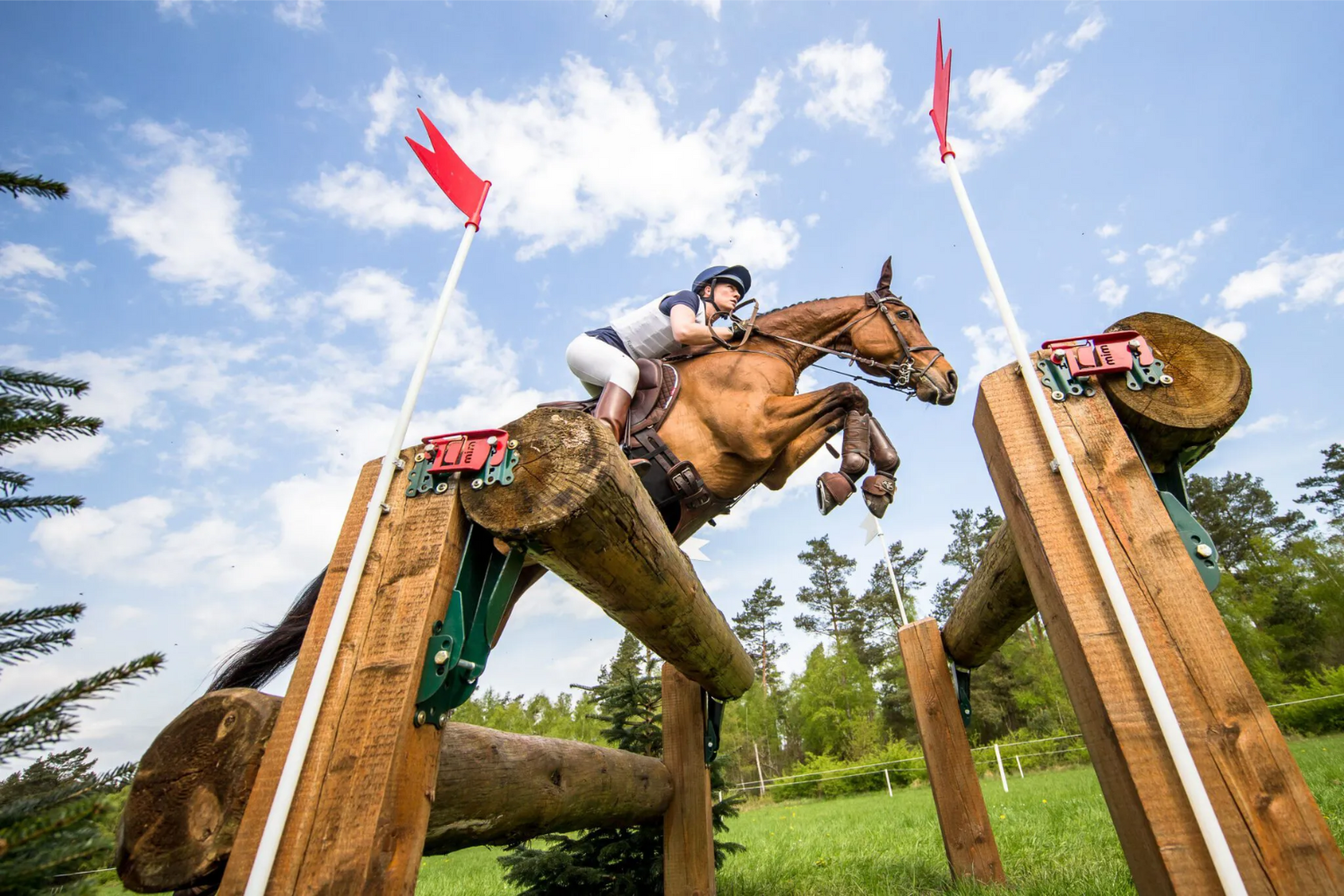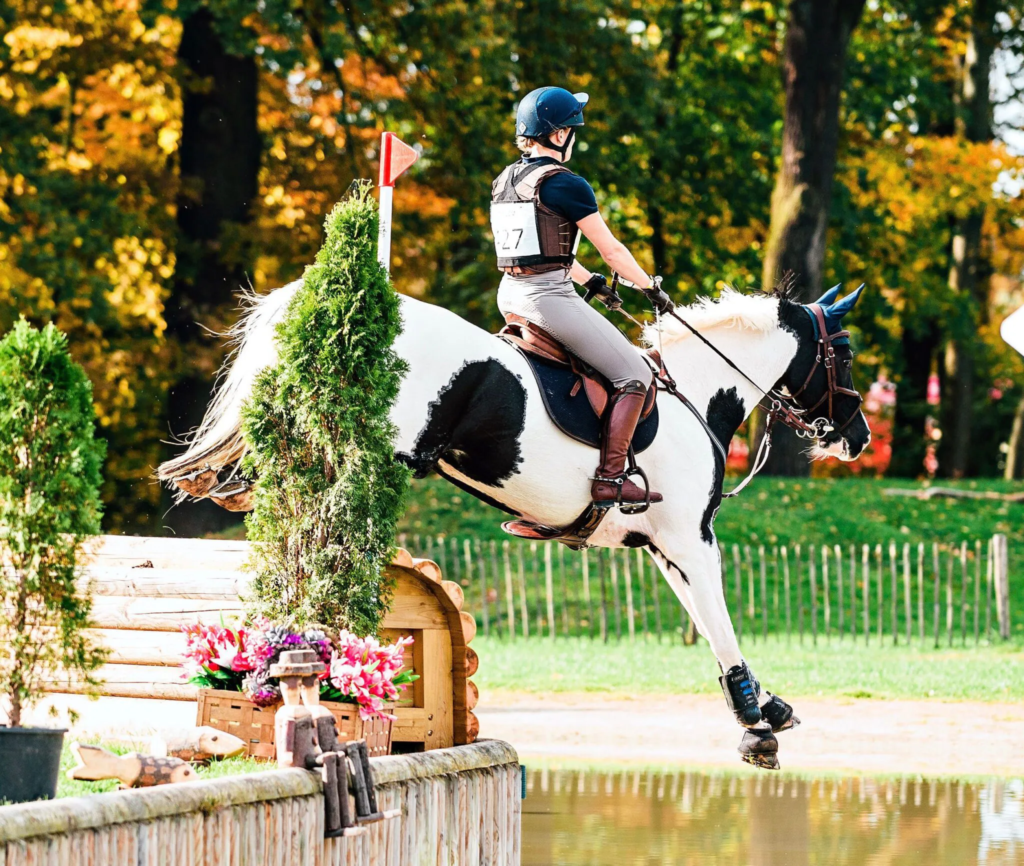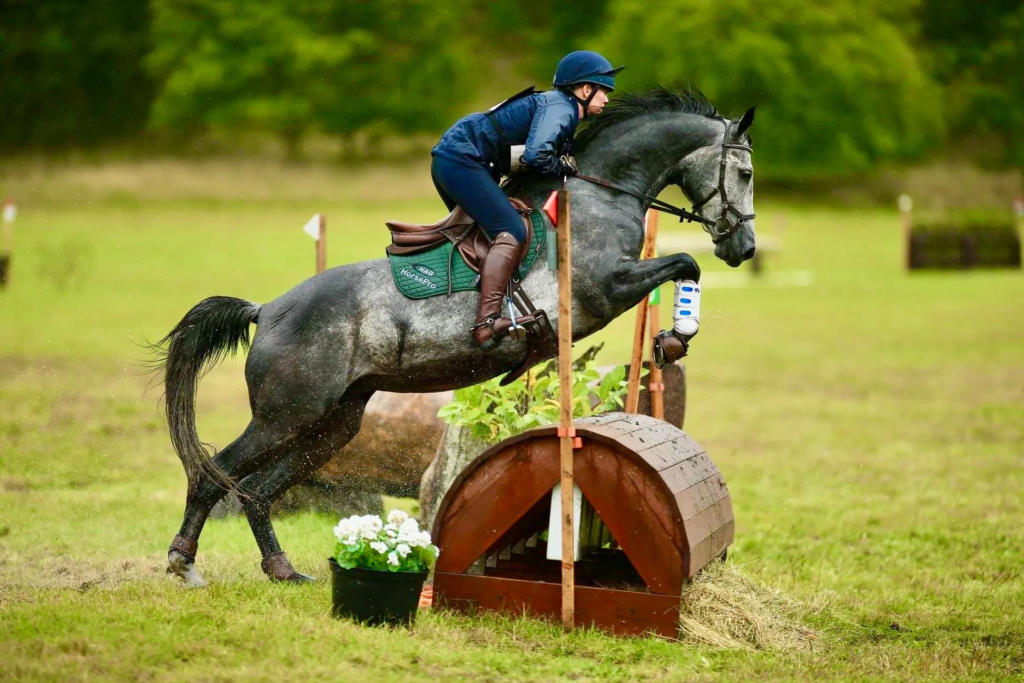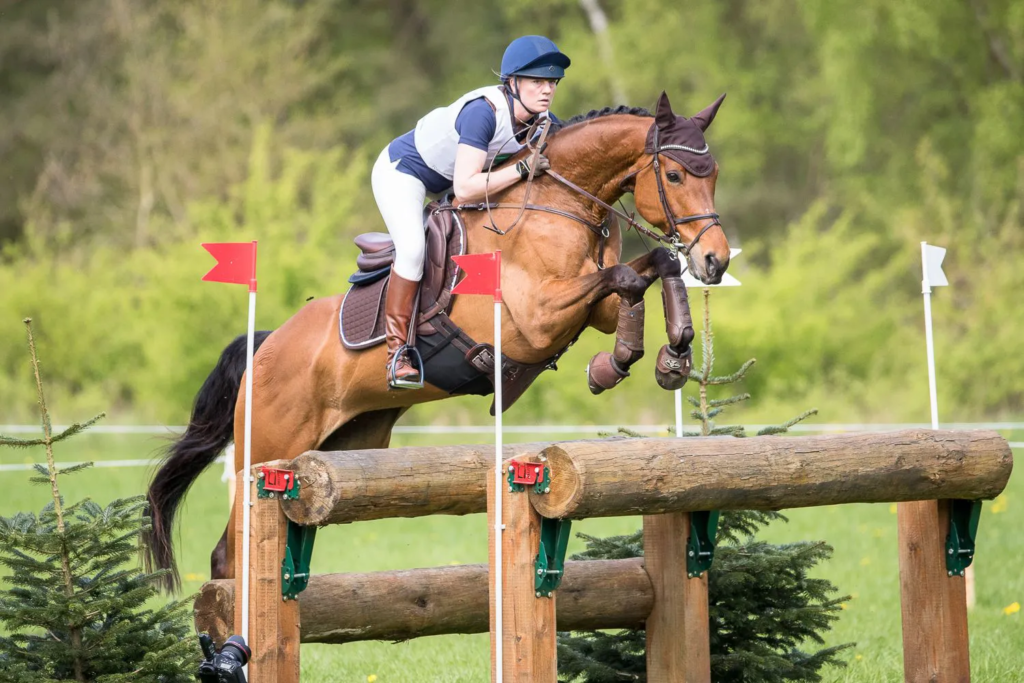Menu

Are you amazed at how some pairs dare to jump over massive tree stumps, huge logs, and deep ditches out in the terrain? Or how eventing riders dare to head towards the large solid obstacles at what seems like more than just full speed on the back of their spirited horses? Moreover, if you're worried about having to go out and confront these solid obstacles in the nature, we're quite sure you're not alone – and we understand you well. Jumping over solid obstacles is certainly not without danger, and one must do their best to know what they are doing. If done right, it can lead to entirely new and challenging, confidence-inspiring experiences with your horse.
To help you feel more confident about this intense equestrian discipline, we interviewed event rider Bianca Bagge. She shares a story about how even a highly skilled terrain rider accustomed to competing at a high level must actively work to keep her cool. According to Bianca, one of the most important things is to have as many good runs as possible to offset the inevitable bad ones if you are fully committed to the sport. However, Bianca emphasizes that for one’s own safety, it is crucial to be realistic about whether one is mentally suited for terrain riding and to remember that building mental strength takes time. Here, you can read Bianca's responses to our questions on how riders can find the courage to dare to jump in the terrain.
Read also: WHAT IS: Mountain Trail
Bianca Bagge
Bianca's four horses
What is important to you when riding and jumping in the terrain?
For me, the most important thing is that it is safe to ride in the terrain. Unfortunately, this also means that I sometimes incur time faults because I prefer to add an extra canter stride if I am unsure about the distance. This cautious approach has stayed with me after a fall I had in 2015. However, it has not made me a worse rider. I just think more about where there might be challenges that require extra attention when walking a course.

Like most event riders, the terrain is clearly my favorite discipline—otherwise, one probably would not ride eventing. I love the speed, the adrenaline, and the complexity. A lot of effort goes into walking a cross-country course—especially in the higher classes (2*-5*). You need a plan for each jump, a plan for the pace, the lines, where you can save time, what kind of footing is around the course, and so on. You need to know your horse, its gallop, and its courage to make a good plan—and I love that.
As a terrain rider, I would say that I am relatively confident without being reckless, which means that I am rarely the fastest in the class. But, on the other hand, I have also not been injured much.
What do you think are the biggest and most important differences between jumping in an arena and jumping in the terrain?
Besides verticals, oxers, and triple bars, there are ditches, water jumps, jumps with deep landings, uphill jumps, downhill jumps, corners, narrow obstacles, and so on. All these different types of obstacles require a different approach, tempo, and setup.
There is a lot that is different about terrain jumping compared to show jumping. Besides the obstacles being solid, there are also many different types of obstacles. It should also be noted that many of the obstacles are no longer 100% solid but are designed to break away if the horse hits the jump hard or lands in it. This system is in place to reduce the risk of rotational falls and is called the MIM system.
The MIM safety system is specifically used in eventing and was invented by Swedish Mats Bjornetun, receiving approval from the FEI (International Equestrian Federation) in 2012. Prior to this approval, it underwent a series of international tests which were later independently verified by a safety consultant and testing expert from the British Transport Research Laboratory. MIM clips allow large obstacles, which previously could not be made to collapse under impact, to break apart when hit with the type of force that typically causes a rotational fall. In a rotational fall, the rider is thrown forward over the horse, and the horse lands on its back over the rider, which can lead to fatalities in the sport of eventing.
Additionally, the type of footing varies, which must also be considered in one's approach and choice of pace. You ride one way if you are on grass and it has rained—and you ride in a different way if it has been dry for a month and the ground is hard.
Lastly, there is the pace. In the terrain, you ride at a significantly higher pace. This makes it easier to make mistakes because the jumps come up faster. So, the only thing that really can be compared between show jumping and terrain jumping is that we are overcoming obstacles. Therefore, it is also important to distinguish between riding 100 cm in show jumping and a CNC100 eventing class. The level of difficulty cannot be compared.
What is your most significant experience in the terrain?
Ida once had challenges with water jumps—most notably at a competition in the spring of 2019. At an event in Germany, we encountered a jump leading into a lake where I experienced a stop. Later that year, at a 3* event in Segersjö, Sweden, they featured one of the toughest water jumps I've ever seen at that level. Less than half of the 46 pairs finished the cross-country phase without faults, and the water jump was indisputably the obstacle that claimed the most errors. Ida was one of the horses that handled this challenging water jump, which involved jumping from a lake into a house, in the most convincing manner. She did it effortlessly. It was an incredible feeling.
What is essential for becoming a brave and mentally strong terrain rider?
Believing in oneself is crucial, along with having a skilled and competent trainer. Equally important is having a good and reliable horse. I have trained all my horses from scratch, but I've been fortunate that they have all been courageous and smart about obstacles, which quickly made me feel safe.

It's important to recognize that you don't become a confident rider overnight. It requires many successful rides. At least, that's how it has been for me. It's the successful rides that build your mental strength and confidence. The more good rides you have under your belt, the more confident you become.
I spent many years advancing to the higher classes (2* and 3*), and this has made both my horses and me confident after so many good and “easy” runs at the lower levels. I started eventing in 2003 but only debuted in 3* ten years later and rode my first 4* in 2019. It has been a gradual progression.
How does the horse contribute to an event rider's self-belief?
It largely depends on the horse you're riding. If the horse isn't capable of the class you're entering—or worse, if it's overly bold without the correct technique and ability—it's difficult to avoid a bad experience. Ida is one of those horses that is completely fearless and throws herself headlong into everything I steer her towards. Therefore, it's my job to ensure a good pace so that the ride over the jump or through the combination doesn't become dangerous. She's a horse that needs to be held back; otherwise, there simply isn't enough space. Fortunately, she has become more obedient with age. She has always been quick on her feet and capable of extricating us from any 'sticky situation.'
The horse's temperament, its gallop, and of course its jumping technique—specifically the technique of the front legs—are some of the most important aspects. When jumping at high speed over solid obstacles, it's essential to have a horse that is quick upfront. Even the best riders in the world occasionally encounter a distance or two that isn't quite right. Here, it's crucial to have a horse that is smart about obstacles and can navigate safely out of the situation.
Bianca Bagge shares an exercise she once learned from five-time Badminton (an international 5* event in England) winner Lucinda Green. The exercise involves riding somewhat randomly over various jumps so that the horse must solve the distance problem on its own. This can improve the horse's ability to read jumps, enabling it to independently navigate and resolve difficult distances at competitions.
Bianca explains that this exercise helps make the horse more intelligent about obstacles: "None of us get it right every time. That’s why it’s so important for the horse to think for itself and find solutions when everything isn’t laid out on a silver platter." However, she also emphasizes the importance of the horse having a good basic canter to properly address these challenges.
Read also: Don't Forget to Draw Inspiration from Other Disciplines
What have you done to move forward after an unpleasant experience in the terrain?
I've fallen twice since I started eventing. In 2015, I broke my arm and damaged a joint in my shoulder. I underwent shoulder surgery a year later and have since had virtually no residual effects. The first time I left the start box after the accident, I felt uneasy. But my mother and a friend reminded me of all the big courses I had ridden without problems, and once I got going, it went just as well as it usually does.
In 2019, I fell at the Nordic Championships in Vilhelmsborg. It was more frustration than fear that hit me. I approached an obstacle too fast and had to make a sharp right turn. Unfortunately, the ground was quite hard, and the studs in Ida's back shoes didn't grip the surface. She slipped, and I ended up landing on my feet. Thankfully, neither she nor I was injured. The experience made me very cautious about the surface and my choice of studs at subsequent competitions. Every time there was a sharp turn, I rode at an even slower pace than usual, as the fear of slipping still lingered. After a few competitions, that fear dissipated, and I've just gained an important lesson about studs, speed, and supporting the outside rein in sharp turns.
What do you think one should do after a bad experience to regain confidence and courage?

I believe it's very important to listen to oneself. As a rule, very few people are capable of making rational decisions if they are paralyzed by fear. If you are truly scared, you should abstain. You don't ride well when you're scared, and that's precisely when you can end up in a potentially dangerous situation. Typically, I don't train cross-country jumping very often on experienced horses. But after my fall in 2015, I trained once a week before registering for a competition again. It helped a lot, and I would definitely recommend it if you find yourself in such a situation.
It's also important to remember how much you've ridden without issues previously, and that maybe this one time was just an anomaly. This thought was very significant for me when I fell. The rest of the 2015 season, I rode very cautiously. It was important to me that all distances were exactly right, and I took no chances. Since then, I've thankfully moved on and become a less reckless and more secure terrain rider.
We hope this article helps you find the courage when you need to jump in the terrain.
Read also: 6 useful groundwork exercises